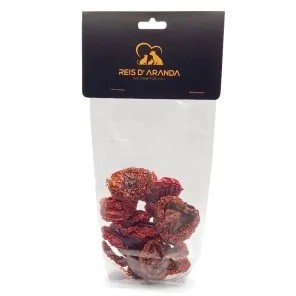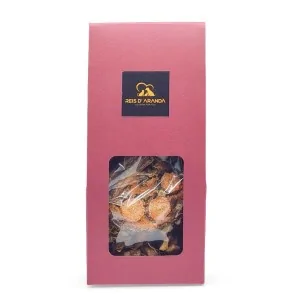Its name says it all: the Vienna blue rabbit comes from Austria. Not only is it beautiful with its shiny blue-grey...
How to Prevent Obesity in Guinea Pigs?
Understanding Obesity in Guinea Pigs
Obesity is an increasingly common pathology in our society and pets are not free from it. In the case of guinea pigs (also called "guinea pigs", "guinea pigs" or "guinea pigs"), it is not as frequent as it happens in dogs or cats, but this disease is increasingly present in them as well.
In the following article, we will see what obesity is, how to identify its symptoms in guinea pigs and how to prevent it.
What is obesity in guinea pigs?
Obesity is defined as a "pathological state characterized by an excess or excessive and general accumulation of fat in the body".
Guinea pigs are gluttonous and anxious animals that, at the slightest noise of bags or drawers in the kitchen, begin to squeal and demand that you give them any of those things you are handling (whether or not they are suitable for them), their rounded shapes and "potato" appearance make it complex to know when our guinea pig is chubby or at its weight, since this varies according to age, sex (at this point no differences are seen until after 15 months) and even the breed, since a guinea pig of American breed / self (short hair) or a US-Teddy, are much heavier than the Abyssinian (swirled hair) or sheltie (long hair).
The weight of female guinea pigs at adulthood varies between 700g and 900g (doubling during pregnancy), while males weigh between 900g and 1,200kg. In the past, guinea pigs reached weights of 1,500kg and 1,800kg at adulthood, especially as food animals in their countries of origin.
Signs of Obesity
In guinea pigs, because of their body shapes, it is complex to know if they are fat or obese, but there are symptoms that we can recognize at a glance.
One of the easiest symptoms to recognize is the weight and the big and sagging belly; it is important to weigh our guinea pig every week and keep track in a notebook, in this way we can observe if there are significant increases or decreases in weight in our pet, which could indicate that something is wrong. On the other hand, we have to be sure that our guinea pig is not pregnant (the shape of the belly of a pregnant guinea pig is not the same as that of an obese guinea pig); it is important to have our guinea pigs well sexed, especially if they live in a group, have been adopted from a private individual or come from a conventional pet store (not owned by a federated breeder, but the store acts as an intermediary).
Other symptoms of obesity are slow and clumsy movements, the refusal of the animal to play or practice any type of exercise, forced breathing, tired appearance, pododermatitis in hands and/or feet, dirty anogenital area because it cannot be cleaned, hyperkeratosis in the ears and belly, and wounds in the areas of greater friction or with folds (contact ulcers).
Causes of Obesity
Obesity can have (in general) many causes: from bad eating habits to medicinal origins, genetic predisposition, lack of exercise, previous illnesses...
In guinea pigs, most of the time it arises from an inadequate diet, low in fiber and very rich in carbohydrates, sugars and fats. Guinea pigs that are fed almost exclusively on low quality commercial feed without any control on the quantity, without access to hay or vegetables that should eat every day, and inhabit very small cages that do not allow them to exercise.
Healthy Food for Guinea Pigs
We all know that a healthy diet is essential for a healthy weight and a better quality of life. And as owners and protectors of our guinea pigs, it is essential that we pay attention to the food we give them, its frequency and quantity, if we want them to live many years by our side (the average life expectancy of a guinea pig is between 5 and 8 years).
Although guinea pigs are rodents like rats, mice and hamsters, they do not have the same diet as these, guinea pigs are entirely herbivorous animals (their cousins mentioned above are omnivorous) so their diet should be based on plants and vegetables.
The 80% of our guinea pig's daily diet should be made up of hay, having to offer a quality hay, clean of dust, pleasant to the touch and aroma, with an attractive color (not yellow). Guinea pigs need a lot of fiber in their diet (like rabbits) so that their digestive tract works properly and they do not develop problems such as gas accumulation or intestinal stoppages; this kind of problems are very dangerous and painful and, if not treated in time, can lead to death.
Likewise, hay helps them to correctly file their incisors and molars, preventing dental overgrowth and acquired malocclusion.
15% of their daily diet should be composed of fresh and varied salads, they are rich in vitamins and minerals, they hydrate our guinea pig (especially in summer time), and they love them!
Guinea pigs cannot synthesize vitamin C on their own, so it is up to humans to provide them with vitamin C-rich salads and treats. They should never be confused with fruits. The salad will be daily (one a day) and will weigh between 30 gr and 50 gr.
The next food (which makes up 5% of the daily diet of our guinea pig) is the feed; this is a complement to their diet and we must always choose a quality one. We will never opt for supermarket feed, which are distinguished by being "mueslies" composed of pellets, corn, seeds, various seeds and colorful additives that resemble breakfast cereals.
A good feed is uniform (pellets only) or includes flowers and plants in their natural form, with a minimum fiber percentage of 20%, without by-products in its composition, flours, vegetables or non-specific ingredients, beet pulp, syrups, animal products (such as honey), salt, additives or preservatives.
Snacks (treats), should be given very occasionally and we will always opt for natural options such as dried fruit or handmade pastry products of Reis d'Aranda. We will look for those products made mainly from hay, or those where hay is among the first ingredients (in the ingredient lists, they go from higher to lower quantity).
Type of food
VEGETABLES SUITABLE FOR GUINEA PIGS
-Chard
-Celery
-Chicory
-Cress
-Lamb's lettuce
-Escarole
-Green beans (seedless)
-Bell pepper
Green beans (seeded) -Endive
-Borage
-Artichoke
-Arugula
-Cucumber
-Zucchini
-Spinach
-Broccoli stems
-Carrot leaves
Carrot (very little quantity) -Carrot leaves (very little quantity)
-Romaine lettuce
VEGETABLES NOT SUITABLE FOR GUINEA PIGS
-Potatoes and all tubers
-Garlic and garlic
-Onions
-Pork
-Iceberg lettuce
-Cauliflower
FRUITS SUITABLE FOR GUINEA PIGS
-Apple
-Peach
-Domaschino(apricot)
-Melon
-Watermelon
-Pear
-Panana
-Litchi(without skin and seed)
-Nectarine
-Paraguayan
-Ciruela
-Cherries
-Strawberries
-Blueberries
-Blackberries
-Raspberries
-Roseberries
-Orange
-Mango
-Papaya
-Tangerine
-Ripe tomatoes
OTHER INELIGIBLE FOODS
-Foods of animal origin (honey, dairy, pollen...)
-Dog or cat food
-Dried fruits
-Pulses
-Aggocado
-Unripe tomato(green) and the whole plant (leaves and stems)
-Chocolate
-Fruits in syrup
Portion Control
As discussed above:
HAY: 80% (80%)
VEGETABLES: 15% (30-50gr)
FOOD: 5%.
GOLOSINS: Very occasionally.
Snacks and treats
The treats and snacks that we offer to our guinea pig should be as natural as possible, the main ingredient (or one of these) should be hay, and we will try to reject all those containing additives or preservatives.
Some great options are the cookies and cakes made by the brand Reis d'Aranda, which has a wide variety of treats for guinea pigs as tasty as they are creative.
We can use them to gain their confidence when we get home, train them to do simple tricks or congratulate them for something well done (for example, doing their needs in a specific point of their habitat).
Exercise and Physical Activity
Cages are not an appropriate place for our guinea pigs as most commercially available cages are too small for them. It is best to provide them with a 2 x 2 meter playpen made of removable panels (there are metal and plastic ones), adding 0.5 meters in both width and length for each guinea pig included in the group; the floor should be covered with pressed paper pellets or smooth polar blankets (without lint, which can get tangled in the fingers). Although these measures may seem sufficient, our guinea pigs will have to go out to exercise for a minimum of 2 hours a day, at which time they can explore with the proper precautions, run around and jump.
Immobilization when living in a place that is too small not only helps to develop obesity, but also diseases such as pododermatitis.
Space to play
The ideal is to set up a room for our guinea pigs where they can play quietly and live in semi-freedom, if this is not possible, we will make them a park that is much larger than their habitat, where we will place booths, toys and other elements that invite them to use their brains and make an effort.
Do you want to know if your guinea pig is happy in their playground? This is called "palomiteo" and it is a very funny thing, its maximum expression of happiness.
Toys and Stimulation
We can choose toys made of untreated wood (if it is colored, use vegetable dyes), esparto grass, tunnels for cats, different little houses where they can play hide and seek, branches of fruit trees (dry and without pesticides)...
Daily Exercise
Establish a daily exercise routine for your guinea pig, including time for running and exploring (minimum 2 hours per day).
Medical Care and Prevention
Regular veterinary visits are essential to prevent health problems in guinea pigs. It is recommended that our guinea pig goes to the vet every 6 months for a general check-up, if he/she is over 4 years old, it is recommended to go every 3 months.
Identifying Health Problems
Guinea pigs (like rabbits), are prey animals that hide very well that they are sick so as not to appear weak to their predators .Knowing how to recognize the symptoms of pain or illness is very important to be able to solve it, since intervening too late can be fatal. Some symptoms of illness in guinea pigs are:
- Does not want to move, stays in a corner in a ball .
- Does not want to eat
- Doesnot want to drink
- She is lethargic (half asleep).
- She cries
- Stomach makes piping noises (gassy)
- Grindsteeth with squinting eyes
- Watery eyes
- Genital area very dirty and wet (diarrhea)
- Red and/or swollen feetand hands
- White plaques with dandruff on skin (mites)
- Dirty, dull and dull-looking coat
- Bald spots
- Stomach very hard and sounds like a drum when tapped with fingertips (gas)
- Strange, foul-smelling fluids in the genial area
- Reddish or red urine (pour hydrogen peroxide, if foam comes out see vet)
Problems urinating or pain when urinating
Unsteady gait (falls down, looks drunk)
Conclusion
Keeping your guinea pig at a healthy weight is essential to its overall well-being. Follow these tips and guidelines to prevent obesity and ensure your beloved pet lives a long and happy life.
Frequently Asked Questions
What are the risks of obesity in guinea pigs?
Obesity can lead to mobility problems, development of osteoarthritis or arthritis, cellulitis infections, contact sores and ulcers, pododermatitis, breathing problems, brain and heart disease, as well as myiasis (fly larvae infestation) due to inability to clean their private areas.
How often should I weigh my guinea pig?
It is always recommended to weigh your guinea pig once a week and write it down in a notebook. If you see that it has gained or lost a lot of weight compared to the last entry, go to the vet (in summer, it is normal for them to lose a little weight due to the heat, as they eat less and drink more).
What do I do if my guinea pig is already obese?
Consult a veterinarian specializing in small animals to create a weight loss plan.
Can I give my guinea pig fruit?
Yes, but in moderation. Fruits should be a supplement to their main diet.
What is the life expectancy of life expectancy of a guinea pig?
With proper care, guinea pigs can live between 5 and 8 years.
Remember, obesity in guinea pigs is preventable. With the right information and care, you can ensure that your lovable pet will live a long and healthy life.
Leave a comment
Log in to post comments
















